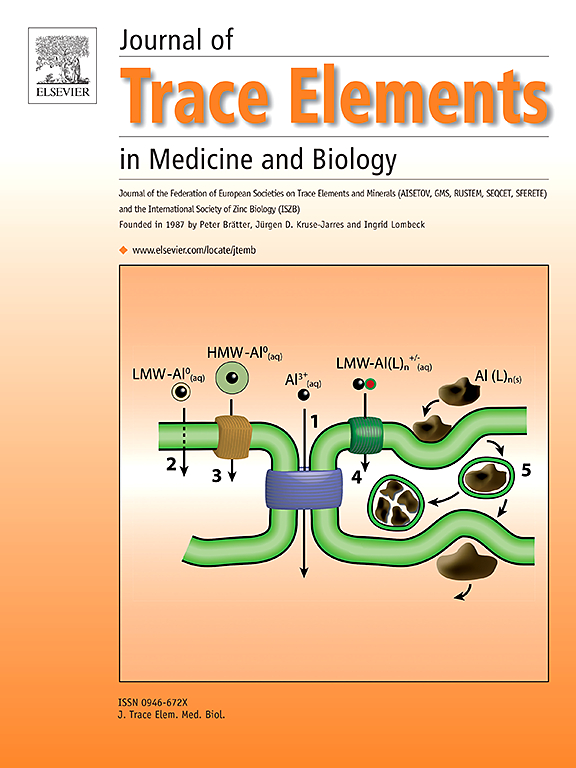Associations of blood selenium with dyslipidemia in children and adolescents: a cross-sectional analysis
IF 3.6
3区 医学
Q2 BIOCHEMISTRY & MOLECULAR BIOLOGY
Journal of Trace Elements in Medicine and Biology
Pub Date : 2025-02-01
DOI:10.1016/j.jtemb.2025.127596
引用次数: 0
Abstract
Objective
This study aims to examine the association between blood selenium levels and dyslipidemia in children and adolescents.
Methods
Data from the National Health and Nutrition Examination Survey (NHANES) 2011–2020 were analyzed, including 8191 participants aged 6–19 years. Dyslipidemia was defined by elevated total cholesterol (TC ≥ 200 mg/dL), lowered high-density lipoprotein cholesterol (HDL-C < 40 mg/dL), or elevated non-HDL-C (≥ 145 mg/dL). Associations between blood selenium levels and dyslipidemia were examined using multivariate logistic regression, linear regression, and restricted cubic spline (RCS) analysis.
Results
The study population had a mean age of 12.33 years, with 51.21 % boys. After adjusting for multiple confounding factors, including dietary selenium intakes and supplementation, higher blood selenium levels were associated with increased odds of dyslipidemia and its components. In the highest quartile of blood selenium (>193.99 μg/L), adjusted odds ratios (ORs) were 1.60 (95 % confidence interval [CI]: 1.23–2.08) for dyslipidemia, 1.70 (95 % CI: 1.19–2.43) for elevated TC, 1.38 (95 % CI: 0.97–1.96) for lowered HDL-C, and 1.73 (95 % CI: 1.20–2.48) for elevated non-HDL-C. A significant nonlinear association was observed, with dyslipidemia prevalence increasing notably above a threshold of 184.28 μg/L (P-nonlinearity=0.02), following a J-shaped curve. Subgroup analysis revealed significant interaction by race (P-interaction=0.02), with non-Hispanic White individuals showing a stronger association (OR=1.83, 95 % CI: 1.19–2.80) compared to other racial groups (OR=1.40, 95 % CI: 1.05–1.88).
Conclusion
Elevated blood selenium levels are associated with higher prevalence of dyslipidemia in children and adolescents, particularly among non-Hispanic White individuals. The association is nonlinear, with a notable increase in the prevalence of dyslipidemia observed above a blood selenium level of 184.28 μg/L. These findings suggest a need for further research to understand selenium's role in lipid profiles and its implications for public health.
血硒与儿童和青少年血脂异常的关系:一项横断面分析。
目的:探讨儿童和青少年血硒水平与血脂异常的关系。方法:分析2011-2020年国家健康与营养检查调查(NHANES)的数据,包括8191名6-19岁的参与者。血脂异常的定义是总胆固醇升高(TC≥200 mg/dL)、高密度脂蛋白胆固醇降低(HDL-C < 40 mg/dL)或非HDL-C升高(≥145 mg/dL)。采用多变量logistic回归、线性回归和限制性三次样条(RCS)分析检验血硒水平与血脂异常之间的关系。结果:研究人群的平均年龄为12.33岁,男孩占51.21 %。在调整了多种混杂因素(包括膳食硒摄入量和补充)后,较高的血硒水平与血脂异常及其组成部分的几率增加有关。在血硒含量最高的四分位数(bb0 193.99 μg/L)中,血脂异常的校正比值比为1.60(95% %可信区间[CI]: 1.23-2.08), TC升高的校正比值比为1.70(95% % CI: 1.19-2.43), HDL-C降低的校正比值比为1.38(95 % CI: 0.97-1.96),非HDL-C升高的校正比值比为1.73(95 % CI: 1.20-2.48)。观察到显著的非线性关联,血脂异常患病率在阈值184.28 μg/L以上显著增加(p -非线性=0.02),呈j型曲线。亚组分析显示种族之间存在显著的相互作用(p -相互作用=0.02),与其他种族相比,非西班牙裔白人个体表现出更强的相关性(OR=1.83, 95 % CI: 1.19-2.80) (OR=1.40, 95 % CI: 1.05-1.88)。结论:血硒水平升高与儿童和青少年血脂异常患病率升高有关,特别是在非西班牙裔白人中。这种关联是非线性的,血硒水平高于184.28 μg/L时,血脂异常的发生率显著增加。这些发现表明需要进一步研究以了解硒在脂质谱中的作用及其对公众健康的影响。
本文章由计算机程序翻译,如有差异,请以英文原文为准。
求助全文
约1分钟内获得全文
求助全文
来源期刊
CiteScore
6.60
自引率
2.90%
发文量
202
审稿时长
85 days
期刊介绍:
The journal provides the reader with a thorough description of theoretical and applied aspects of trace elements in medicine and biology and is devoted to the advancement of scientific knowledge about trace elements and trace element species. Trace elements play essential roles in the maintenance of physiological processes. During the last decades there has been a great deal of scientific investigation about the function and binding of trace elements. The Journal of Trace Elements in Medicine and Biology focuses on the description and dissemination of scientific results concerning the role of trace elements with respect to their mode of action in health and disease and nutritional importance. Progress in the knowledge of the biological role of trace elements depends, however, on advances in trace elements chemistry. Thus the Journal of Trace Elements in Medicine and Biology will include only those papers that base their results on proven analytical methods.
Also, we only publish those articles in which the quality assurance regarding the execution of experiments and achievement of results is guaranteed.

 求助内容:
求助内容: 应助结果提醒方式:
应助结果提醒方式:


